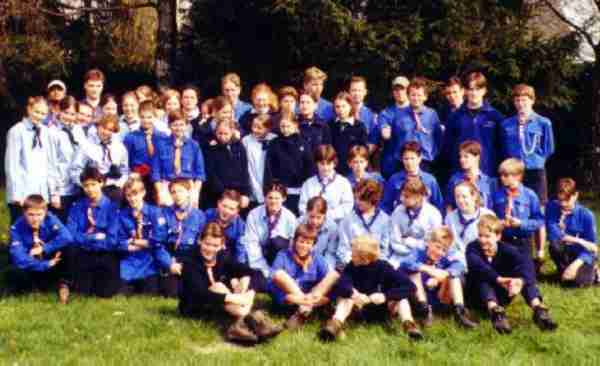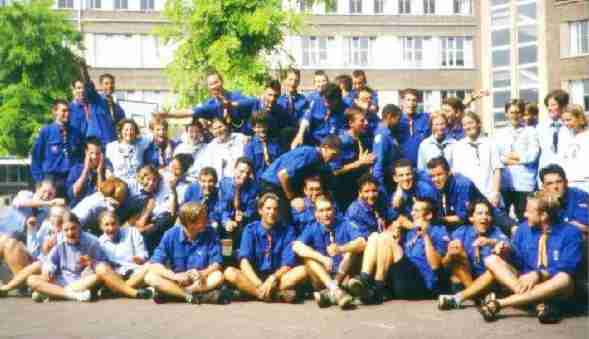
Figure 1.--These KSA members were photographed in the 1990s. I'm not quite sure what the different color shirts reflect, but it looks like the girls have the light blue shirts. The KSA looks much like a Scout group.


Figure 1.--These KSA members were photographed in the 1990s. I'm not quite sure what the different color shirts reflect, but it looks like the girls have the light blue shirts. The KSA looks much like a Scout group. |
The Katholieke Studentenactie (KSA) wears a uniform that looks very much like a Scout group. But it is not a Scout association. The KSA has nothing to do with Lord Baden-Powell and the World Scouting movement. I think it may best be described
as a scion of the 'patronaat'-group of youth movements that have been fostered by the Roman Catholic Church. It is also primarily located in the Flemish areas of Belgium. The KSA is similar to Chiro. The two movements, however, recruit their members from different sections of society. KSA groups are always linked to a school. That school usually is a 'college' i.e. a priest-run form of secondary education that is meant to prepare boys for entering university--or indeed priesthood. A "college" in France and Belgium is a secondary school, not a under-graduate university as in the United States.) This means a private, fee-paying school so that the KSA members come from a more religious and more affluent sector of the population than more working class organizations like Chiro. KSA members were generally children from about 11 to 18 years old. Some Belgian colleges are single gender schools so that there are both coed and single-gender KSA units. Belgian colleges tend to prefer the KSA to associations with Scouts as there is more school control over the religious program and activites.
Katholieke Studenten Actie or Catholic Students Action (KSA) was originaly just for boys. Almost each KSA group started in a catholic school (secondary level colleges). Nowadays they can be everywhere. For girls there was a similar organisation the Vrouwelijke Katholieke Studerende Jeugd or Feminin Catholic Studying Youth (VKSJ). There was a fusion in the 1970s to form the Katholieke Studerende Jeugd (KSJ) which combined the KSA and VKSJ into a mixed coed group with both genders together. Many groups didn't want to changed to a coed approach did not join the KSJ.

Figure 2.--This KSA unit looks to be older students. They are all uniformed, with boys in dark blue shirts and girls in light blue shirts. All of the boy appear to be wearing black short pants. There appears to be no rule about shoes and socks. |
The Katholieke Studentenactie (KSA) wears a uniform that looks very much like a Scout group. But it is not a Scout association. The KSA has nothing to do with Lord Baden-Powell and the World Scouting movement.
I think it may best be described as a scion of the 'patronaat'-group of youth movements that have been fostered by the Roman Catholic Church.
It is also primarily located in the Flemish areas of Belgium.
The KSA is similar to Chiro. The two movements, however, recruit their members from different sections of society. KSA groups are always linked to a school. That school usually is a 'college' i.e. a priest-run form of secondary education that is meant to prepare boys for entering university--or indeed priesthood. A "college" in France and Belgium is a secondary school, not a under-graduate university as in the United States.) Belgian colleges tend to prefer the KSA to associations with Scouts as there is more school control over the religious program and activites.
Some Belgian colleges are single gender schools so that there are both coed and single-gender KSA units. The coed units or KSJ ynits which fused the KSA with the the VKSJ. The units that decided not to go coed are still called the KSA.
KSA members were generally children from about 11 to 18 years old. Some units look to be composed mostly of oler pupils. This reflects the organization of KSA units at secondary schools. There is no KSA level for younger boys like Cubbing in Scouts,

Figure 3.--While the shirts are different colors, both the girls an boys wear black pants. The girls may also wear black skirts, although it is difficult to tell from the available images. |
This means a private, fee-paying school so that the KSA members come from a more religious and more affluent sector of the population than more working class organizations like Chiro.
T he KSA insists on a uniform. They appear to have a stricter uniform policy than many Europeam youth organizations. As in Scouting, there appears to be some differences between units as to how strictly the unifornm regulations are enforced from group to group. Many units, however, do not appear to give cosierable attention to the uniform. The KSA has no cap or hat as part of their uniform. The members wear blue shirts. The the girls who are in a separate but associate group wear light bue shirts and the boys bright blue shirts. Some members wear a dark blue sweater or jacket. Some members wear kerchiefs. Here the girls wear blue kerchiefs and the boys red and yellow ones. Many members do not wear kerchiefs. Members wear dark blue long or short trousers.
HBC has noted the following garments worn by KSA members
There does not seem to be a KSA cap.
Some images show younger members wearing what looks to be darl blue jacket or blazer. Both boys and girls wear them.
The KSA has gender specific shirts. The gir;s wear light blue shirts and the boys wear bright blue shirts. Note how few patches and badges the KSA members wear on their shirts in comparison to Scouts.

Figure 4.--There appears to be no sandard as to footwear and socks. None of the boys wear kneesocks. Some wear open-toe sport sandals. |
Many but not all members wear kerchiefs. The girls wear dark blue kerchiefs. The boys wear different colore kerchiefs. Presumably the boys in ifferent units wear destinctively colored kerchiefs, I'm not sure why all the girls wear plain blue ones.
The members wear both long and short dark blue pants. HNC is not sure what the rule was. It seems to vary between units.
There appears to be no standar as to socks. As with many European youth groups by the 1990s, none of the boys wear kneesocks.
The KSA appears to have no standard as to footwear. Some boys wear open-toe sport sandals.
HBC finds the splintering of the Belgian youth movement interesting. Belgium is a very small country, yet the youth movement is splintered on ethnic, religious, and social class lines. The result is limitations on interactions between these groups. Compare this with the United States where te youth movement is dominated by the overall Scouting movement. While the American Scouts are still for the most part gender exclusive and there are some religious exclusivity (some units organized by curches), racial exclusivity (neigborhood organization) and has a middle-class bias, it still brings together boys of a wide range of religious, ethnic, and social backgrounds.
Navigate the Historic Boys' Uniform Chronology Pages:
[Return to the Main chronologies page]
[The 1900s]
[The 1910s]
[The 1920s]
[The 1930s]
[The 1940s]
[The 1950s]
[The 1960s]
[The 1970s]
[The 1980s]
[The 1990s]
[The 2000s]
Navigate the Historic Boys' Uniform Web Site:
[Introduction]
[Activities]
[Biographies]
[Chronologies]
[Countries]
[Essays]
[Organizations]
[Other]
[Unknown]
[Bibliographies]
[FAQs]
[Contributions]
[Boys' Uniform Home]
Navigate the Historic Boys' Uniform Web organizatiion pages:
[Return to the Main Belgian nationalist organization page]
[Return to the Main Belgian country page]
[Return to the Main religious organization page]
[Boys' Brigade]
[Camp Fire]
[Hitler Youth]
[National]
[Pioneers]
[Royal Rangers]
[Scout]
